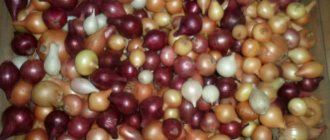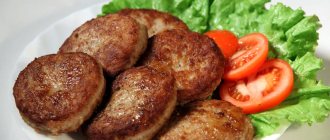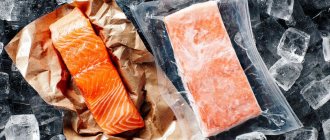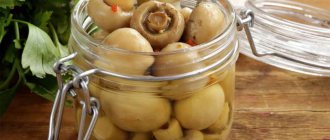If the refrigerator is constantly stocked with food, but it seems like there is nothing to eat, you should think about it and reconsider your habits. Proper storage will not only extend the shelf life of food, but will also help you make healthier choices. If you always have fresh vegetables and fruits in the house, the desire to snack on something harmful will be much less. These five tips will help preserve the taste and beneficial properties of your food longer.
Top 7 “forbidden” foods that prevent you from getting perfect abs
How to properly store food
Many people believe that refrigeration reliably preserves not only fresh supplies, but also cooked food. This opinion is wrong. There is constant air exchange in the chamber. Improper placement of dishes leads to the fact that dirt and harmful substances quickly spread throughout all compartments. There is an unpleasant smell in the departments, and food spoils faster. Food in the chambers is protected from the negative effects of light and heat, but can spoil due to exposure to air.
Many people ask what is the best way to store food in the refrigerator so that it does not dry out. All prepared food and preparations in dishes should be covered with lids or wrapped in cling film. Some supplies can be placed in a container or other sealed container, packed in parchment or a special paper bag. Vegetables and fruits should not be kept unpackaged. Because they quickly weather and dry out.
Regular “audit” and cleaning
If you prefer to buy food for future use and load the refrigerator, for example, once a week, it is worth conducting a regular “audit”. Check not only the expiration date, but also the condition of the food: sometimes it can go bad, even if the date on the package says otherwise.
Photo: istockphoto.com
Also, don't forget to clean your refrigerator thoroughly. This way, the food will stay fresh longer, and the device itself will better maintain the temperature and consume less electricity.
What to contain
It is recommended to place vegetables and fruits in boxes in their original packaging. It retains the right amount of moisture and prevents them from becoming chapped. In models with a No Frost cooling system, due to intensive air exchange, the drying process occurs faster. The basic rules for storing food in the refrigerator mention that food must be in the appropriate container:
Glass containers are considered the most durable. They preserve the freshness of any food and are inert to odors. Wooden and plastic containers need to be replaced as they wear out. It should be remembered that scratches and minor defects accumulate many microbes. Cling film and plastic bags are not suitable for long-term preservation of food. These materials accumulate condensation, lead to mold and the growth of dangerous bacteria.
Middle shelf
On the middle shelf it is recommended to store leftover food, open canned food and groceries and everything that does not require special conditions.
Buy more small plates. You will have to wipe down the shelves in the refrigerator much less often if you train yourself to put all the dirty food on saucers. Opened jars of sprat, leftover sausage and half an onion should all be placed on separate plates of suitable size.
Use a swivel stand. Do you often find something long gone bad in the depths of your refrigerator? Place some of the food on the rotating stand to make it easier to reach. This way you can store perishable foods, and, for example, jars of sauces and seasonings.
InterDesign stand RUR 1,560
Sign everything. If you do not live alone and do not always know how and when this or that food got into the refrigerator, make it a rule to write on each product the date it was opened.
Proper storage of food in the refrigerator according to timing
Raw lump meat can be stored in the refrigerator for up to 24–48 hours. The larger the piece, the longer it can sit. It is advisable to put the minced meat in the freezer. It is subject to rapid spoilage due to the active development of pathogenic bacteria in it. Poultry carcasses, ham, brawn, dairy, sausages are suitable for consumption within 72 hours. Certain types of food are stored within the following periods:
- fish – 2 days;
- minced meat – 1 day;
- ham and smoked meats – up to 1 week in original packaging;
- eggs – 7 days in a special container;
- fresh herbs – 2 days;
- butter – 15–30 days;
- ketchup – 7 days;
- hard cheese – up to 3 weeks;
- condensed milk – up to 5 days;
- processed cheese – 15 days;
- sourdough, sour cream, yogurt – 72 hours.
Sliced meats and smoked meats are packaged hermetically so that they do not weather during long-term storage of food in the refrigerator. Salads are served only without dressing; they are suitable for consumption within 24 hours. It is advisable to eat prepared dishes within 2 days. When left in the cold for longer, they lose nutritional value. Baked goods have a limited shelf life. Desserts with cream are stored for 12 hours, pies with fillings - up to 1 day. Canned vegetables in glass containers should be consumed within 15 days after opening the jar. Sandwiches packed in cling film should be eaten within 4–5 hours.
Top shelf
The temperature inside the refrigerator is not the same: the higher it is, the warmer it is, and this is important to take into account when storing food. It is usually recommended to store open canned food, yoghurts, frozen berries, and sometimes eggs and cheese on the top shelf.
Store food in containers. A pot with leftover soup will take up the entire shelf (if it fits on it at all), and a small container will fit neatly in an empty corner. It’s better to immediately buy a set of containers of different sizes, preferably glass. They are more environmentally friendly, safer, and food can be heated directly in them.
Container IKEA Fertrolig 349 rub.
Store bottles correctly. If you're annoyed by bottles and cans rolling around on shelves, buy a mat that will hold them in place and even allow them to pile up. Wine can be placed in special compartments or simply put a stopper on the bottle. Well, owners of refrigerators with a very spacious top shelf will like the idea of attaching bottles using powerful magnets.
Quirky bottle stopper $10, InterDesign shelf $13, BottleLoft magnetic holder $39, Fridge Monkey mat $13
Buy universal lids. They come in the form of silicone “caps” or regular lids. They can be used to cover a plate with leftover food, an open jar of canned food, or even half a watermelon.
Universal lids Lekue 1855 RUR, 697 RUR
Temperature
Compliance with the zoning of the refrigerator will extend the storage time. The temperature at different levels is not the same. In single-chamber units, the shelf under the freezer is considered the coldest. This zone maintains 1–3˚С. In other places it can vary in the range of 1–8˚С. The degree of cooling can be adjusted manually. The freezer is maintained at 15–23˚ frost. The values in the doors are unstable due to frequent opening and closing, which causes temperature changes. The mode for different types of products in the refrigerator compartment differs:
- dairy – 1˚С;
- fresh fish – 0˚С;
- eggs - 1˚C in a container that is stored in the refrigerator on a shelf;
- finished products prepared thermally – 2˚С;
- fresh meat – 1˚С;
- bakery products and desserts –3˚С;
- fruits and vegetables – 4˚С.
Some models of equipment allow you to adjust the cooling of both the refrigerator and freezer compartments. Different foods require a certain temperature regime. The optimal temperature for the refrigerator compartment is 2–5˚С, for the freezer compartment -18–24˚С. In models with the No Frost system, air exchange is arranged to provide different modes in certain storage areas in the refrigerator and freezer drawers. In units with a freezer located at the bottom, the warmest place is the top shelf, the coolest is the bottom.
Differences between departments
Different levels are used to cool food in containers and dishes. Some models of equipment have built-in containers for certain supplies. They increase the shelf life of the contents. The temperature in the general compartment near the walls and in the immediate vicinity of the freezer compartment is lower. The numbers can be adjusted within 1–8˚C heat, but 5˚C is considered optimal. Below we will look at how to organize space in the refrigerator - label the shelves and distribute dishes on them.
Compartment under freezer
Ideal for perishable products. Here the temperature is maintained within 1–3˚С. It is best to pack the cheese in a glass container or wrap it in foil. To preserve the taste longer, you can place a piece of refined sugar in the container. Sugar absorbs excess moisture and increases the shelf life of cheese up to two weeks. Cut the butter into portions. Leave one portion in the butter dish on the shelf, the rest should be placed in the freezer.
All food is placed in containers for proper organization in the refrigerator; a photo of an example of optimal placement is offered in the operating instructions. Cottage cheese that is not vacuum packed is placed in a glass tray or vacuum container. It is recommended to pour milk from plastic packaging into clean and dry glass containers with a lid. Eggs can be placed in plastic or cardboard trays. You can’t put them in the door, otherwise the warm air provokes the development of salmonella. Frequent changes lead to drying out and rotten eggs.
Second and third shelves
These zones are universal and are used for thermally processed dishes, salads, and smoked meats in accordance with the rules for storing food in the refrigerator. Large pans fit perfectly at the bottom, small ones at the top. It is recommended to consume prepared food within 2 days. Some culinary products have a limited shelf life:
- Cakes and pastries – 8–12 hours.
- Salads with butter - up to 18 hours.
- Soups and borscht – 1 day.
- Cooked meat products – 48 hours.
- Salads with mayonnaise or sour cream – up to 12 hours.
- Opened canned meat and fish - up to 72 hours.
- Dishes with potatoes – up to 1 day.
- Opened canned vegetables – up to 14 days.
Supplies are laid out so that they do not touch each other. You can’t force the shelf to capacity, otherwise air exchange and cooling intensity will be disrupted. For large quantities of contents, it is recommended to lower the temperature to 2–4˚.
Door
The door is considered the warmest area. It often opens, so there are differences in heat and coolness. This area is great for spices, seasonings and sauces. It is not advisable to place eggs in the door. Temperature fluctuations reduce their shelf life. This is also an ideal place for medications that require a lower temperature than indoors. The door is not suitable for cooling juices and milk.
Zero compartment or bottom drawers
Designed for storing food products such as fresh vegetables and fruits, herbs in the refrigerator. Air exchange in the boxes maintains optimal humidity so that the contents do not dry out. Fresh Box, Flex Cool, Fresh Zone sections increase shelf life. The zero compartment is divided:
- For the humid zone – 0˚С and humidity 90% are maintained. Greens, vegetables and fruits are pre-washed, dried and packaged. Should not be placed in a plastic bag. Condensation will accumulate in such containers. It is recommended to place the berries in separate containers.
- Dry – maintained at 0˚C and humidity 50%. This is the best place to preserve fresh fish and meat. Fish products are first cleaned of scales and entrails and washed. Under such conditions, storage of products in the refrigerator is allowed for up to 7 days.
To prevent condensation from collecting inside the packaging, choose well-ventilated containers. Cabbage wrapped in cling film will be usable for 20 days, tomatoes in a vegetable container or bag for up to 10 days, cucumbers, radishes and sweet peppers for up to 15 days, and carrots for 2 months. The cut watermelon and melon are covered with cling film and left for only 12 hours. Berries in containers remain fresh for up to 3 days, apples and firm apricots for up to 2 weeks.
If there is no organization of space in the refrigerator into freshness zones, you can preserve bunches of greenery in several ways. Clean branches are placed in a glass container and covered with a lid. The bundle can be wrapped in a damp rag and then packed into a bag. Greens in a jar of water will fit on any shelf.
Freezer
Freezing extends the use time by several months. The minimum value is 18˚C below zero. The more densely packed the freezer is, the lower the setting should be. If the compartment is filled to capacity, it is recommended to set the enhanced mode within the range of -20–25˚С. Here is a different procedure for storing food in the refrigerator:
- before freezing, blanks and semi-finished products are divided into portions;
- Do not re-freeze already thawed products;
- the berries need to be washed and dried, the vegetables need to be additionally cut into portions;
- Any plastic bags or frost-resistant containers are suitable for packaging.
To understand whether the mode is set correctly, evaluate the quality of freezing. If the container is covered with ice, the degree of cooling can be left at the same level or reduced. If condensation appears on the packages, the value must be lowered. The shelf life of food in the refrigerator depends on the temperature and type of food:
- meat – at – 14–18˚ up to 6 months;
- fish - at -18˚ sea fish are suitable for up to 8 months, river fish - up to six months;
- berries, fruits, vegetables - at -18˚ they retain their properties for 1 year.
To improve the storage term, do not lower the cooling mode below the recommended level. Too low levels negatively affect the structure of meat, fish and vegetables. The beneficial properties of the preparations are lost. Reducing the numbers to lower values is appropriate when the freezer is densely filled.
What not to contain
Many people do not know how to properly store various types of food in the refrigerator, so they put heat-loving exotic fruits, hot food, and uncovered dishes that can form condensation on the shelves. It should be remembered that some food does not need refrigeration, some may lose their presentable appearance. They can be placed in a closet away from radiators and other heat sources. Do not keep in the refrigerator:
- tropical fruits rot from the cold;
- pumpkin, zucchini, zucchini, cucumbers - become moldy and rot due to moisture inside, they should only be placed in a special compartment;
- apples and pears - at low temperatures they produce polyethylene, which has a detrimental effect on neighboring supplies if the products are not properly organized in the refrigerator;
- olive oil – begins to taste bitter;
- honey – loses its beneficial properties and thickens when exposed to cold;
- bread – moistens and absorbs foreign odors;
- chocolate and chocolate candies are covered with a white coating;
- potatoes - when exposed to strong cooling, they rot;
- garlic – grows actively in the cold;
- onions - become limp due to loss of moisture.
When arranging supplies on shelves, you should remember that the undesirable proximity of some dishes negatively affects other types of food. To prevent extraneous odors from impairing the quality and taste of other products, all containers are covered with lids or cling film. Organizing food storage in the refrigerator will be correct if the food does not come into contact with each other.
Raw meat and fish can transfer pathogenic bacteria and microorganisms to prepared dishes. Cheese, dairy, fruits and vegetables cannot be combined with smoked meats. Eggs are not placed next to any preparations. It is recommended to place salads away from fruits, and oils away from spices. Every week, the shelves need to be cleaned of crumbs and foreign odors with a damp cloth. A solution of soda or lemon juice is suitable for this purpose.
Bottom shelf
It is recommended to store raw meat on the coldest shelf (here it will not only stay fresh longer, but is also guaranteed not to leak onto the food below), milk and eggs.
Do not place ready-to-eat foods here. It is best to keep them away from raw meat and eggs.
Store eggs in cardboard packaging. It is better not to transfer them to a new container or to a special compartment on the door: in the original cardboard packaging they will last longer and are guaranteed not to break. But if you are really annoyed by the standard “clutter”, buy a beautiful tray: it will be easier to maintain order among your favorite things.
Egg tray 999 rub.











